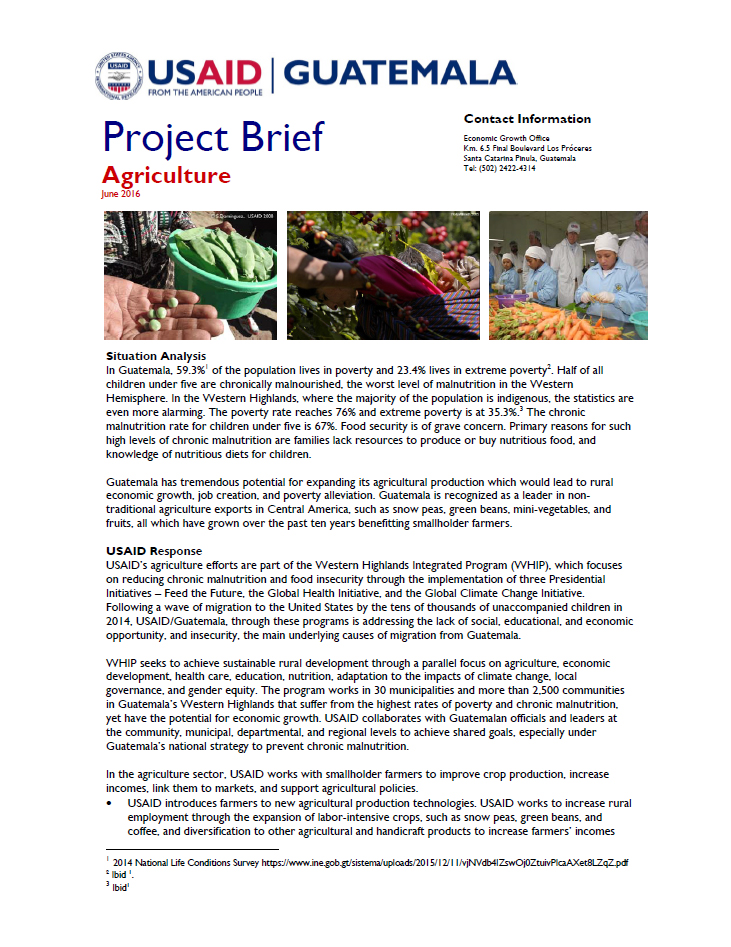Situation Analysis
Sector Brief - Agriculture ![]() (pdf - 186k)
(pdf - 186k)
In Guatemala, 54% of the population lives in poverty and 13% lives in extreme poverty. Half of all children under five are chronically malnourished, the worst level of malnutrition in the Western Hemisphere.
In the Western Highlands of the country, where the majority of the population is indigenous, the statistics are even more alarming. The poverty rate reaches 76% and extreme poverty is at 27%. The chronic malnutrition rate for children under five is 67%.
Food security is of grave concern. One of the primary reasons for such high levels of chronic malnutrition is that families lack resources to produce or buy nutritious food, as well as knowledge of nutritious diets for children.
Guatemala has tremendous potential for expanding its agricultural production which would lead to rural economic growth, job creation, and poverty alleviation. Guatemala is recognized as a leader in non-traditional agriculture exports in Central America, such as snow peas, green beans, mini-vegetables, and fruits, which have grown exponentially over the past ten years benefitting smallholder farmers.
USAID Response
USAID’s agriculture efforts are part of the Western Highlands Integrated Program, which focuses on reducing chronic malnutrition and improving food security through the implementation of three Presidential Initiatives – Feed the Future, the Global Health Initiative, and the Global Climate Change Initiative.
The Western Highlands Integrated Program seeks to achieve sustainable rural development through parallel focus on agriculture, economic development, health care, education, nutrition, adaptation to the impacts of climate change, local governance, and gender equity. The Integrated Program works in 30 municipalities and more than 2,500 communities in Guatemala’s Western Highlands that suffer from the highest rates of poverty and chronic malnutrition, yet have the potential for economic growth. USAID collaborates with Guatemalan officials and leaders at the community, municipal, departmental, and regional levels to achieve shared goals, especially under Guatemala’s national plan to reduce chronic malnutrition, known as the Zero Hunger Pact.
In the agriculture sector, USAID works with small farmers to improve crop production, increase incomes, link them to markets, and support agricultural policies.
- USAID introduces male and female farmers to new agricultural production technologies. We work to increase rural employment through the expansion of labor-intensive crops, such as snow peas, green beans, and coffee, and diversification to other agricultural and handicraft products to increase farmers’ incomes. Our activities focus on gender equity and closing gender gaps in the agriculture sector.
- USAID helps strengthen access to markets, and market information, such as prices and demand, for small farmers. USAID helps farmers’ groups improve strategic plans, management practices, business and marketing, financial systems, and access to credit.
- USAID invests in improved productivity of staple foods, such as corn and beans, that reduce the risk associated with shifting from subsistence farming to commercial production. Building resilience includes strengthening local government ability to provide basic services and foster economic growth. USAID’s agriculture activities support citizen participation in community organizations and Municipal Development Councils to ensure that farmers’ needs and concerns are addressed.
- The Food for Peace program aligns food assistance resources with complementary activities, such as home gardens and nutrition education sessions for parents, to reach subsistence farmers and build their capacity to participate in USAID’s broader market-focused agriculture activities. The Food for Peace program also strengthens community government organizations to better meet community development needs.
- We work with the U.S. Department of Agriculture to establish and strengthen agricultural trade policy to support food security, and provide training on agricultural export regulations. We also work with the Peace Corps to improve food security in Guatemala’s rural Western Highlands communities.
Results and Accomplishments
USAID’s efforts have resulted in:
- Increased sales – In 2013, USAID’s agricultural activities generated $20.4 million in sales of horticulture, high quality coffee, and handicraft products.
- Employment generation – In 2013, USAID supported the creation of 8,734 full-time jobs.
- Reduced chronic malnutrition – Through USAID’s Food for Peace program, chronic malnutrition was reduced by between 7% and 9% in target communities.
- Increased access to credit – USAID supported access to $20 million of credit for small and medium-scale entrepreneurs in the agriculture, forestry, and tourism sectors via a USAID loan portfolio guarantee agreement with Guatemalan bank Banrural.
Related Links
Blog: Administrator Shah Makes His Debut in Guatemala
Blog: Administrator Shah Observes Guatemala’s Agriculture Value Chain Programs
USAID Helps to End Corruption in Guatemala
Promoting Climate-Smart Agriculture in Guatemala’s Western Highlands
Moving Up the Mountain: Coffee Farmers Fight Against Climate Change
Youth Engagement in Agricultural Value Chains Across Feed the Future: A Synthesis Report
Farmers outsmart Climate Change in Guatemala









Comment
Make a general inquiry or suggest an improvement.